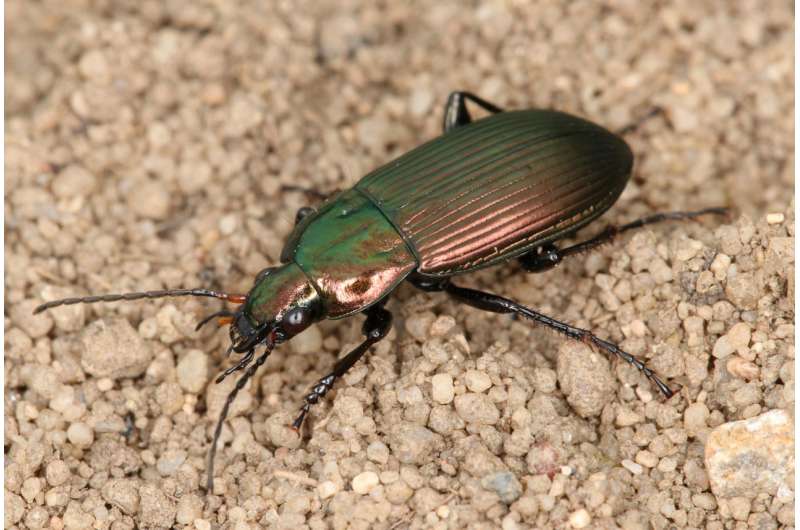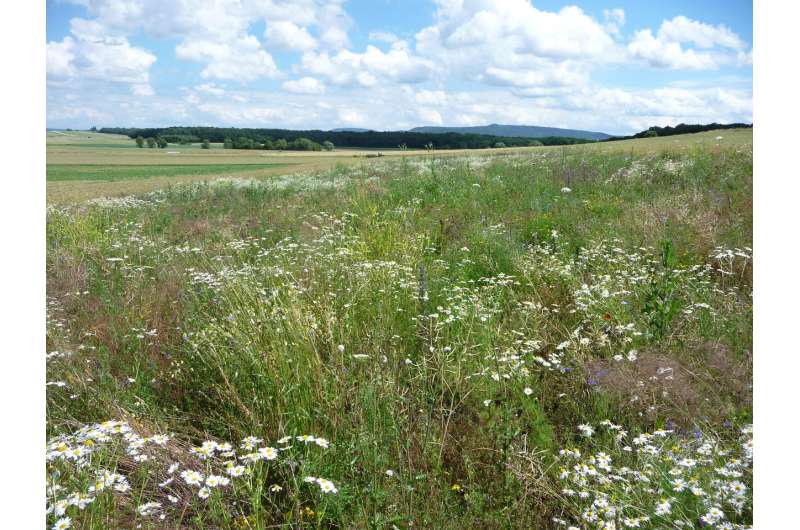The ground beetle copper greenclock (Poecilus cupreus) is a beneficial insect frequently encountered in agricultural landscapes. Credit: Fabian Boetzl
Oilseed rape fields are home to a variety of insects that bother farmers. The pollen beetle is one of them. The beetle's larvae feed on the flower buds of oilseed rape causing damage and crop failure. The larvae of weevil species also have a preference for rape: They tunnel into the plants' stems, making them wither and die.
Conventional farming practice generally relies on chemical pesticides to exterminate the hungry insects. But obviously their populations can also be kept at bay by promoting their natural enemies. These include ground beetles, spiders and other predatory insects that live on the ground.
"They eat the pests' larvae when they drop to the ground to pupate," says Professor Jochen Krauß, a biologist at the Biocentre of Julius-Maximilians-Universität Würzburg (JMU) in Bavaria, Germany. As a result, there are fewer pests on the fields in the next year. Earlier studies showed that the predatory insects are quite efficient at fighting the rapeseed pests.
How can farmers promote the natural enemies of rape pests in modern agricultural landscapes? The research team from the JMU Chair of Animal Ecology and Tropical Biology has found that this can be achieved with the help of flowering areas and other so-called agri-environmental schemes. These measures are specified by the government and are relatively well-established on German farmland. But when it comes to implementing the measures, better strategic and tactical planning are necessary, as the researchers report in the Journal of Applied Ecology.
Flowering fields and ecological focus areas are either plots of arable land lying fallow where farmers seed flowering plants or arable fields that have developed into meadow-like habitats. "Such land provides permanently good living conditions for the enemies of rape pests. From there, the predators can set out to raid the fields and devour the pests' larvae," says Professor Ingolf Steffan-Dewenter, who holds the chair.
Valuable for agricultural landscapes: a young flowering field in full blossom. Credit: Fabian Boetzl
"We encountered twice as many predatory ground beetles in oilseed rape fields bordering a field with an agri-environmental scheme than on other rape fields," says Ph.D. student Fabian Bötzl. As the distance to the flowering plot increases, the number of predatory species and individuals decreases. Distance is a decisive factor of effective natural pest control, because the density and diversity of predators is crucial in this respect.
"Agri-environmental schemes have the same effect as semi-natural habitats. This demonstrates how valuable these measures are for the agricultural landscape," the JMU ecologist says, and recommends incorporating flowering areas and other refuges for animals in agricultural landscapes in a strategic and evenly distributed approach. This not only promotes wild bees and other pollinators, it also supports the natural enemies of pest insects. The distance effects discovered by the researchers can now be used to determine best farming practices based on model calculations and simulations.
The research team studied 31 areas around Würzburg in northern Bavaria between the towns of Gemünden, Ochsenfurt and Hassfurt to obtain the results. They investigated the effects of older and more recent flowering areas, of ecological focus areas and of semi-natural calcareous grasslands.
The diversity and number of predators that are active on the ground surface (beetles and spiders) were determined by using pitfall traps. The experiment was conducted over a period of three months during the growth period of oilseed rape to be able to assess the natural pest control during this time.
More information: Fabian A. Boetzl et al, Agri-environmental schemes promote ground-dwelling predators in adjacent oilseed rape fields: Diversity, species traits and distance-decay functions, Journal of Applied Ecology (2018). DOI: 10.1111/1365-2664.13162
Journal information: Journal of Applied Ecology
Provided by University of Würzburg























